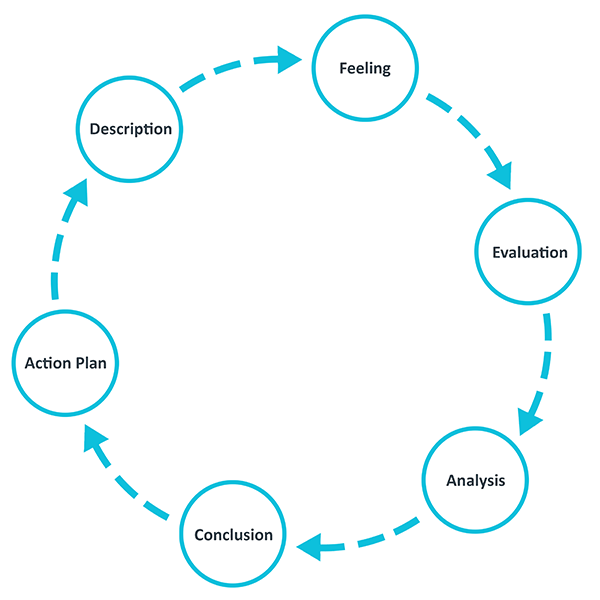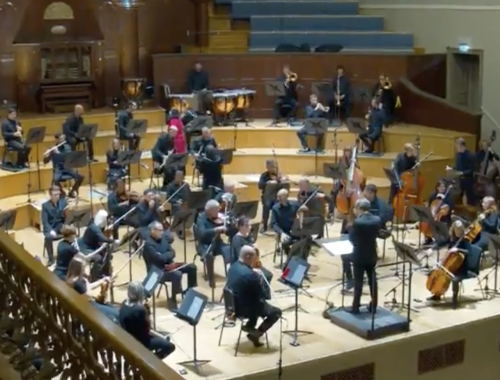Plunged into placement
My very first experience with my placement was not a reflection of a typical day. It was an evening meeting where I assigned the classes I would be teaching, what time each class was and was filled in on anything important that I was to note about specific children. My other responsibilities for the year were also outlined to me to ensure I felt comfortable and capable that I could carry them out for the academic year. My placement is at a fiddle association that takes classes every Saturday morning and runs concerts throughout the year to showcase to parents the progress their children have made. My first official day was much more hectic than a chat with a cup of tea and the rest of the teaching team. It was for at least part of the day, chaos to say the least.
I am going to use the Gibb’s Reflective Cycle as my model for reflective practice because I think it really clearly sets out how to effectively engage in reflective practice and can be extremely useful, especially when beginning a new job where you need to navigate completely unknown territory. The outline for this model can be seen below:

Description
My first day began at 9:40 setting up the room for my classes and organising my materials. The first class of the day is the beginner fiddle class of children ages 4-10. This class was truly a baptism of fire. What took my a bit by surprise was the sheer amount of energy the children came to class with early on a Saturday morning. Energy levels that I myself had not yet mustered up. The class began with introducing myself and the other teachers to all of the children and a get to know you portion of the class where all of the children had the opportunity to say their name and establish if the knew anyone else in the class. Some of the younger children were practically bouncing off the walls while others were quiet and overwhelmed being a foreign environment with of children they didn’t know. I tried to calm the nerves of the children who needed it by giving them lots of encouragement when they would answer a question right or put their hand up without being called upon. By the end of their forty minute class, I felt like I had been hit by a brick wall.
The next class I was assigned to take was a Grade 3 class. It was much smaller and with students who were already competent on the fiddle that needed walked through the tunes that they were to learn for their exam. After the Grade 3 class, the staff would have their break before the final lesson of the day. The final lesson was a senior class of pupils aged 16-22 wishing to complete their Grade or Diploma in Traditional Irish fiddle. For this class I was not the lead teacher but expected to assist as I had already completed my Diploma when I was in secondary school.
Feelings

When I started the first day of teaching classes, I had felt quite nervous about wether or not I was going to be able to engage the younger children in their lessons and that feeling persisted after teaching the beginner class in the morning. They had been so boisterous and hard to contain that I felt a little helpless when trying to figure out how I was going to contain them and ensure that they left having gotten something from my lesson each week. The rest of the classes I felt confident in my abilities to do my job and do it to a high standard.
Evaluation
Upon reflection I think my approach to the class worked quite well given that it was the children’s first day at the association as well as mine. The get to know you part of the class worked well for beginning to settle the nerves of the quieter children and make them feel more comfortable. I don’t think planning any more would have been very beneficial because I didn’t know any of the children, their personalities or what was going to work for them. What I think I could have gone better is having more materials ready for the pupils to take home as homework from their first lesson to get them set up for the following week.
Analysis
Reflecting on the entire day, I feel that I was thrown in the deep end and managed the pressure very well considering my lack of experience in teaching a class of such young pupils and being so heavily outnumbered by the pupils. The rest of the day made me feel comfortable and helped me get my footing. I walked away from that first day feeling slightly out of my depth but with a sense that with some work and direction I was going to be able to handle the jobs that I was assigned. The rest of the teaching staff made sure I knew that they were available for any help, advice or support that I needed.
Conclusion/ Action Plan
From reflecting on my first proper day of placement, I realised that I needed to find a way to break up the beginner class in order to hold the attention of the children since they were so young and didn’t have a very long attention span. For future lessons, I planned to bring a bean bag to throw to the children when it was their turn to answer a question. I also in future classes would pick a point halfway through the lesson for all the children to get up and run two or three laps around the hall their lesson was in to help blow off some steam and stop them getting restless and losing interest half way through. I also think bringing a whiteboard to give visuals for parts of the lesson would help aid concentration rather than the children only listening to my voice for the whole lesson.
Bibliography
Bolton, G. (2001) Reflective practice : writing and professional development. Paul Chapman. Available at: https://search.ebscohost.com/login.aspx?direct=true&db=cat02616a&AN=qub.b1522966x&site=eds-live&scope=site (Accessed: 26 November 2021).
Reflective practice (2000). Carfax Publishing – Part of Taylor & Francis. Available at: https://search.ebscohost.com/login.aspx?direct=true&db=cat02616a&AN=qub.b15089411&site=eds-live&scope=site (Accessed: 26 November 2021).
Everyone Must Start Somewhere...
You May Also Like

In at the Deep End: Recording an Orchestra
26 November 2021
Breaking into the Film Industry: What You Know or Who You Know?
24 November 2021
